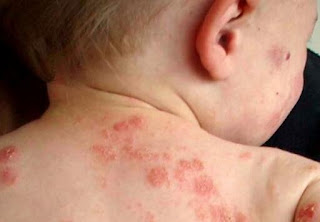Eczema is a chronic itchy skin condition. Eczema usually starts within the
first five years of life, most often in the first six months. It typically lasts
into childhood and adolescence. In some cases it may last into adulthood. Eczema
tends to wax and wane. There are periods of time where the skin appears mildly
affected or even normal, alternating with periods of moderate to severe
involvement. Some children have very mild eczema and others have severe eczema
(also known as atopic dermatitis).
Eczema tends to be more common in families that have a history of eczema, hay
fever, and asthma. These disorders are all a part of what is called the “atopic
triad.” A first or second degree relative with a history of one of these atopic
conditions can often be identified in the family of a child with eczema.
Children with eczema may be more likely to develop allergies or asthma but one
does not cause the other.
In young babies, eczema is most prominent on the cheeks, forehead, and scalp.
It may affect most of the body but usually spares the diaper area. At 6 to 12
months of age, it is often worst on the crawling surfaces, the elbows and knees.
Around the age of two the distribution changes and tends to involve the creases
of the elbows and knees, the wrists, ankles, and hands. It may affect the skin
around the mouth and the eyelids. Older children and adolescents may have eczema
only involving the hands.
In young babies eczema tends to be more red and weepy. In toddlers and older
children it often appears more dry, and the skin may be thickened with prominent
skin lines (a skin change called lichenification).
How to treat eczema in baby
Treating eczema requires treating both skin dryness and skin inflammation. A
good bathing routine is necessary to treat skin dryness. Anti-inflammatory
medications, like topical steroids or topical calcineurin inhibitors (TCIs), are
used to treat inflammation. Occasionally, oral anti-inflammatory agents are
needed to treat the most severe cases.

No comments:
Post a Comment